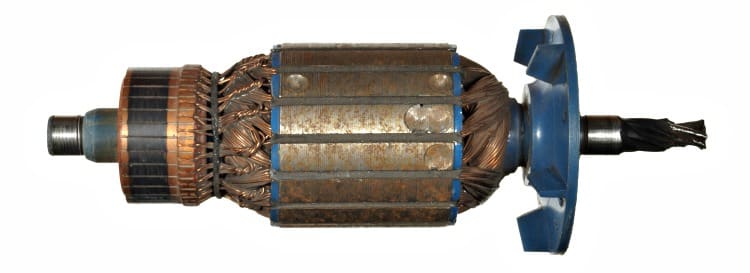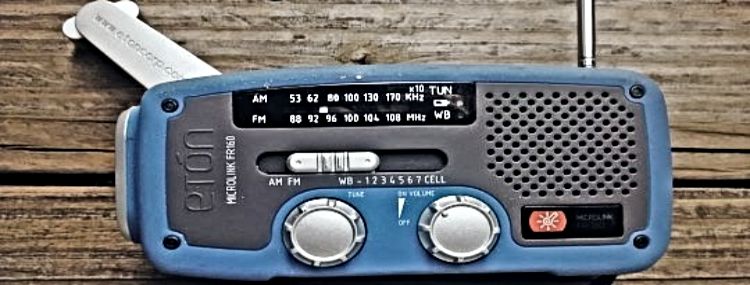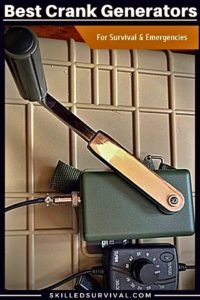
These often-overlooked devices are like little personal power plants that let you turn your calories into electricity—basically, your body becomes the battery. How cool is that?
You get to burn those extra snacks for something useful, like charging your phone or powering up essential gear.
Perfect for those long-term power outages when you can’t rely on the grid:
Best Hand Crank Generators On The Market Today
Here are a few of best hand-cranked generators available on the market today:
Kaito has been making quality radios since 1998.
The Kaito KA500 Voyager is an excellent choice for your hand crank emergency radio.
It has multiple charging methods, such as the hand-crank, USB port (for USB charging), and solar chargers; the KA500 can also use standard AA batteries. And the AA battery is practically a worldwide standard.
It features AM/FM, weather and shortwave frequencies, and Alert mode. It also has LED flashlight modes, which provide extra signaling options.
And the best feature is the number of unique charging options. This makes it one of the most resilient survival radio options.
That's why I consider it one of the best emergency radios ever.
Side Note: I hate dealing with aaa battery options and tend to avoid them.
↓ Kaio Voyager KA500 AM FM Emergency Radio Review
The Huban High Power generator is a military-inspired device.
That's why it has a practical look and feel.
No extra features or gimmicks, but it does its job efficiently and quickly.
Most users notice the increased torque needed in this model.
If you secure it to a table leg, post, or small tree, you can save yourself a lot of muscle fatigue.
This setup also allows you to alternate arms, which is an excellent idea since I promise you'll get tired of cranking.
As with many smaller units, the output is variable due to inconsistencies in crank speed.
This variability may trigger the "device not supported" warning while charging smartphones.
To get around this, charge a battery pack with it and then use the pack to charge the phone.
The battery pack has a more acceptable range of input voltages. Thus, it can be a buffer between the generator and the phone.
PROS
- Higher output power
- Durable build
CONS
- No internal battery
- It needs a sturdy attachment point
↓ Free Power Emergency Hand Crank Dynamo Generator
K-TOR makes some of the best-regarded emergency power options available. And this USB 1Amp hand-cranked generator is no exception.
It's dead simple, as it charges directly via a 1 amp USB outlet. It's also compatible with nearly all headlamps, cell phones, and battery packs.
It doesn't have an internal battery, which is a blessing and a curse.
It means you'll have to charge your device or carry a separate battery pack directly. But it also cuts the weight and size of the unit dramatically.
PROS
- Small
- Lightweight
- Very durable
- Universally accepted USB outlet
CONS
- No internal battery
- The handle could be more comfortable
↓ K-TOR Pocket Socket Hand Crank Generator
RunningSnail is a new brand to me. But the same overall design appears from multiple sources online.
The RunningSnail is a combination device. It features a hand-cranked generator and a built-in suite of emergency, weather, and AM/FM radios. Plus, it can double as an emergency flashlight and motion sensor light.
It also features a small solar cell to provide a secondary charging source in good weather.
It even has a removable 18650 Li-ion battery. This feature allows you to charge these standard batteries for use in other devices without a mess of cords.
PROS
- Removable 18650 Li-ion battery
- Many add-on features combined into one device
- 4000mAh internal battery capacity
CONS
- A solar panel is slow to charge
- Beware of counterfeits
↓ RunningSnail Emergency Hand Crank Radio Review
The FosPower Emergency hand crank charger is another multiple-use device. It's one that can perform a lot of emergency tasks in one package.
It features the same solar and hand crank options found elsewhere. But it also comes with the opportunity to power it via 3 AAA batteries.
You can charge these batteries via the hand crank or solar cell and use them elsewhere. It's a great addition with standard battery size.
A 3-band radio (AM/FM/NOAA), LED flashlight, and reading lamp rounds out the feature set.
PROS
- Small and lightweight
- Charges AAA batteries
- Radio better than others in this size/price range
CONS
- Solar cells are slow to charge
- The handle is not very comfortable and feels a little flimsy
- No "alerts only" option for NOAA weather channels
↓ Pospower Solar Crank Radio Charger Review
Moving on into a larger and more stationery design is the Ranzhix Hand Generator. It's a robust, tabletop unit that would do best strapped to a table or benchtop.
It has a wide range of output power settings and connections. This feature makes it a versatile option for charging multiple devices.
The large handle and long crank arm allow a comfortable grip and maximum applied power. This design helps with easier cranking.
PROS
- Easy to crank thanks to the long handle and comfortable grip
- Solid metal construction
CONS
- Not suitable for portable uses
- It needs a solid base/attachment
↓ Hand Cranked Emergency Generator
Remember when I said we'd see more on pedal-powered generators? Well, here's the first on that list: the K-TOR Power Box 50.
The K-TOR is a simple device that easily fits under a desk or table. It allows the user to crank the pedals and generate electricity while doing other tasks.
I've even seen them used in the office as cycle trainers, even without powering anything.
The standard 12V "cigarette lighter" outlet is easy to use and widely supported. And the 50W output power is higher than anything you're likely to find in a hand-cranked generator.
This option makes perfect sense given that your leg muscles are far larger and stronger than your arms.
PROS
- High power
- Uses more powerful leg muscles
CONS
- Expensive compared to hand-cranked generators
↓ Portable Pedal Generator | Emergency Power
A more permanent installation is the HPG-75 generator. It's a straightforward and efficient pedal-powered generator. This pedal generator can produce up to 75 watts of output power.
With standard bike crank arms and gears, you can customize the fit for you. Plus, you can use spare parts from any standard bicycle.
There are few moving parts outside the chain drive and the generator, so maintenance is a breeze.
You may even find an HPG-75 pedal generator at some science museums. So it's ready for near-constant use (and abuse) by children.
Unfortunately, it doesn't come with standard output connectors. So you'll need to wire it into a battery bank or other distribution system.
PROS
- High output power
- Robust design
CONS
- Need to wire into battery bank or distribution system
A step up in several ways from the HPG-75, the 500W Charging System is a real workhorse. It uses your regular bike as a standard gym trainer.
It's capable of 500 watts of peak power and uses a sophisticated power management system. So most users will comfortably generate 100-150 watts of continuous power.
That's enough power to charge a couple of phones, lights, and small devices at once. And it's also enough to power laptop chargers, desktop computers, a toaster, or even a small blender!
Unfortunately, there's no integrated battery. So you'll still have to connect this system to a battery bank or portable power pack.
This pedal generator is also a bit pricey. But the fact you can use the same bike for both transport and power is an excellent option for cycle enthusiasts!
PROS
- High power output
- Sophisticated charge management
- Uses standard bike on "trainer" stand
CONS
- EXPENSIVE
- It needs a separate battery bank or power pack
Building Your Own Crank Generator Bike
Finally, you might choose to build a crankable generator. If so, this pedal-powered roller generator is a great place to start!
It's well-built and designed for long-term use.
It relies on contact between the roller and your bike tire to rotate the generator. So proper mounting and alignment are critical for success.
You'll want to be somewhat comfortable with minor fabrication tasks. If so, this is a great option to build a system tailored to your needs.
PROS
- Great for DIY generator builds
- Sturdy and low maintenance
CONS
- You need to have some fabrication skills to create a mounting system
Why You Should Own At Least One
In modern times, access to electrical power is commonplace. And most of us take it for granted.
For example:
We rarely find ourselves unable to charge our phones. Airport terminals, coffee shops, and public spaces are all sprouting outlets. Most people don’t even think twice about it. But what about places where a standard 110v outlet isn’t easy to find?
1. Camping Trips
Camping trips are one thing – you can plan and charge your devices beforehand. You can also use them sparingly to conserve battery power. Or find alternatives for power-hungry electronics.
2. Natural Disasters
But emergencies that arise suddenly and without warning can leave you without power.
- Powerful storms can happen at any time of the year
- Strong winds often knock out power lines
- Ice buildup and falling branches can equal weeks without power
Some utility companies have recently started shutting off electricity for preventative reasons. With extremely high winds, a spark could turn into a massive wildfire.
Larger natural disasters like major earthquakes and tsunamis can destroy electrical infrastructure. AND destroy power generation facilities, causing long-term outages.
3. Solar Flares or EMPs
Solar flares or EMPs can play havoc with the electrical grid. Maybe for months! With that in mind, how long would your batteries last? A few days? A week? You need a better plan!
Your backup plan should have several ways to store and produce electrical power. Solar, hydro, and wind power generation are quickly becoming more common. Heck, even large utility companies have gotten on board with these sources.
Smaller versions of these systems are readily adapted to single-family homes. But what if you can’t access free-flowing water, steady wind, or regular sunshine?
There’s one way to generate power that doesn’t rely on any of these outside sources – though you DO have to fuel it!
By fuel, I’m talking about muscle power as a hand-cranked or pedal generator!
You can find all sorts of model types and sizes, for example: There are pocket-sized USB chargers for cell phones. Or there are sizeable permanent generator installations. Ones that wouldn’t look out of place in a professional gym.
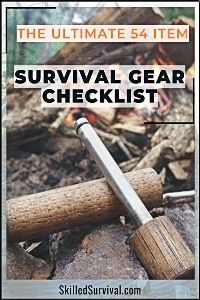
Want a free 54 item survival gear checklist?
Enter your email below to instantly download this Complete Checklist PDF. No purchase necessary. 👇 👇 How A Generator Works
How A Generator Works
Yes, they seem complicated.
For some people, it’s like a black magic box. But the components inside a hand-cranked generator are pretty simple. This simplicity is especially true compared to other forms of power generation.
All electrical generators work by:
- Spinning a coil of wire (rotor) inside a fixed array of magnets (stator).
- The magnetic field interacts with the coiled wire.
- This setup causes electrons to flow through the wire.
Building a small electrical generator is a typical middle school science experiment.
↓ Genecon Hand Crank Generator – Demos & Experiments
Fun fact:
An electrical generator and an electric motor are nearly the same construction. In one case, you spin the rotor to make electricity. On the other, you apply electricity to make the rotor spin.
This phenomenon means you can turn a generator into a motor and vice versa. But only if you understand how to wire each one for the best efficiency.
With generators, you connect them to some form of mechanical power. Ideally, it’s continuous power.
It can spin the rotor and create a constant, reliable, and stable electrical current.
In many cases, including coal, gas, oil, and nuclear-fueled power plants, the heat produced by combustion or nuclear fission is harnessed to create high-pressure steam.
This high-pressure steam then spins a steam turbine that directly drives the rotor. Similarly, wind and hydropower systems spin a turbine and drive the rotor by using flowing air or water.
We can use this example to replace the “thing that spins the rotor” with another power source.
In the case of a hand crank generator, a lever and rotating handle (or pedal) allow you to spin the rotor manually. Thus, generate power as long as you continue cranking.
Some also have the addition of a heavy flywheel. A flywheel helps by adding momentum to generate some power even if you stop cranking.
Now, flywheels take more energy to get up to speed. But it will help even the power output once it’s spinning at full speed.
All the electronics inside regulate and store the electricity generated.
To turn muscle power via cranking a handle into electricity. Now, you must understand how much power you can expect to generate this way…
You cannot power an entire household with one:
Can You Power A House With A Bicycle?
That’s the biggest question. And the answer is No.
↓ Can You Power A House With A Bicycle?
Best Features To Look For
Most hand-crank generators are geared toward camping and emergency markets. But these are relatively broad categories. This means there are many functions and features to look for – depending on your needs.
Understanding these options helps to narrow down the selection process. Thus making choosing the right hand-cranked generator easier.
Power Output
We measure generator output in watts. This output measure allows you to judge what you can and can’t power while using it. Make a list of the items you plan to power. Then pick a generator that powers the LARGEST power need with some energy to spare.
Size
These generators come in a wide range of sizes and capacities.
For example: If mobility is important, you’re better off with a pocket-sized model. Portable devices where you can charge a simple flashlight and cell phone via USB.
It may be worth looking into larger models if you plan to be in one place (home, camper, cabin, boat, etc.). Large ones are more efficient at filling a power bank and appliances.
Weight
Weight goes hand in hand with size. A lightweight hand generator is easier to carry but usually comes at a cost.
Costs such as having:
- a less durable construction
- smaller (or no) internal batteries
- no flywheel to help stabilize power output
Power Storage
Most small hand-cranked generators feature a small internal battery pack. The energy can be stored and accessed via USB or other connections. This setup makes for a more streamlined device and a smaller overall package.
But make sure the internal battery is of sufficient size to power your devices. Otherwise, consider moving up to a larger portable power station model.
Most larger permanent ones come with large external batteries. So this issue is less of a concern.
Add-On Features
Many hand-cranked generators also feature some built-in functions. These “add-ons” help make them better overall emergency tools.
For example:
- LED lights
- solar cells
- emergency radios
They are all common additions to pocket-sized hand-cranked generators.

Want a free 54 item survival gear checklist?
Enter your email below to instantly download this Complete Checklist PDF. No purchase necessary. 👇 👇How To Build One Yourself
Here’s a quick rundown of a few more DIY Crank Generator options, including a bicycle generator. For complete instructions on how to build a DIY bike generator, check out the video below.
It includes details of everything from:
- Building the bike stand
- How to fine-tune the charge controller
- How to maintain the health of your expensive batteries
↓ Homemade Bicycle Generator | Burn Calories and Make Electricity
NOTE: I can’t stress how much I prefer the bicycle generator.
Check out dynamo chargers to build or buy a compact bike generator. They’re perfect for small USB electronics: These allow you to charge your batteries and devices WHILE YOU MOVE ABOUT!
This feature is a massive time and energy savings! It also allows you to reach your destination at full charge. And it takes full advantage of your larger leg muscles!
Final Thoughts
At some point, usually, when you least expect it, you’ll be faced with a lack of power. A backup power source is critical from a passing storm to something more drastic.
One that doesn’t depend on water, wind, or sun is a great option to keep in your backup resiliency plans.
There are many hand-crank and pedal-powered generators on the market—and even more designs to build them if you’re mechanically inclined.
First, take time to figure out your electrical needs and narrow down the field before purchasing. There’s a place for both hand crank and pedal generators. But I think it’s clear you can better use your time spent cranking doing something else instead.
I much prefer a pedal-powered generator. If you agree, you can choose an “under the table” design like the Power Box 50 or HPG-75 or a “full bike” solution like the 500W charging system.
Or you may even go with a DIY alternative.
The bottom line is: Hand crank generators allow you to work on something else while pedaling to a full battery. Now, go rest up; your turn on the crank is next!

Prepare, Adapt & Overcome,
P.s. - I just found out 2 out of 3 Americans don’t feel prepared for a 3 day disaster!!!
I guess this goes to show how modern society continues to embrace ‘living a fragile life.’ What’s crazy is… it’s so easy to fix.
To make sure YOU have the basics, watch our FREE training on “10 Simple Steps To Basic Preparedness” that shows you HOW.
Nothing crazy here… this isn’t doomsday prepping... just the basics every responsible adult should have before a disaster strikes.Why You Can Trust Skilled Survival...
Go here now to review a full breakdown of:
- Who We Are
- Our Credentials
- Our Mission
- & Product Recommendations...
Here are a few highlights of our teams credentials & certifications:
- Certified Member of a Mountain Search & Rescue Organization
- Plant Emergency & Safety Leader for a Major Food Manufacturer
- Member of the 10TH Mountain Division Hut Association
- Certifications: Avalanche 1, WFR, CPR
- Official Gear Tester for Numerous Outdoor Gear Companies
- Countless Multiday Backpacking trips into Remote Wilderness
- Bachelor's Degree In Mechanical Engineering
- Bachelor's Degree In Civil Engineering
- Bachelor's Degree In Biomedical Engineering
"It takes 20 years to build a reputation and five minutes to ruin it." - Warren Buffett
We're fully aware that trust is NOT something you GET but is EARNED.
And we'll continue to earn YOUR trust through our forthright and honest approach with each new Blog Post, Guide & Product we create...
P.s - I just took this FREE 60-second 'Readiness Score Quiz'👇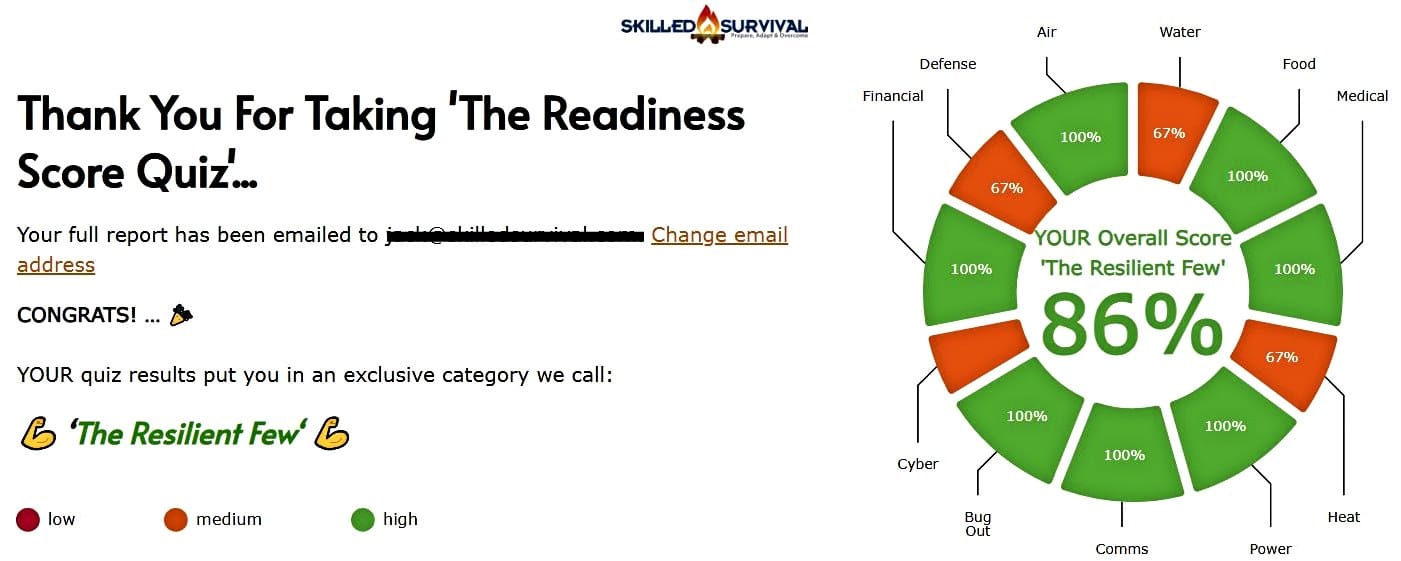
AND... I've still got a few gaps in my preps...🤔 But at least, I'm not part of 'The Fragile Masses'. 👍 Find out where YOU stand by answering a few questions...

Recommended Reading
5 Best Vacuum Sealers Hand-Picked By A Survival Expert
Vacuum sealer are an essential kitchen appliance to keep food fresh and avoid unnecessary waste. We review the top 5 on the market today.
Camping Generator: The Best Setup For Whisper Quiet Power
You need quiet power for both camping and survival. In this article, I share the best camping generator and how to modify it for silence.
9 Best Solar Radios Hand-Picked By A Survival Expert
Everyone needs a solar radio for life-saving weather alerts and emergency information. We share the best solar radios on the market today.
Survival Bag: Best Ones Hand-Picked By Our Gear Expert
Settling on the RIGHT survival bag can be an overwhelming task. But we make it easy by focusing on only the best ones available today.
Portable Power Station: Best Ones For Power Outages
We review the best portable power station on the market. And break down the features you'll want for camping, traveling, and emergencies.
Bluetti AC200P Review: Putting It To The Ultimate Test
We put the Bluetti AC200P power station through its paces as a backup emergency solar generator and a portable camping generator.











